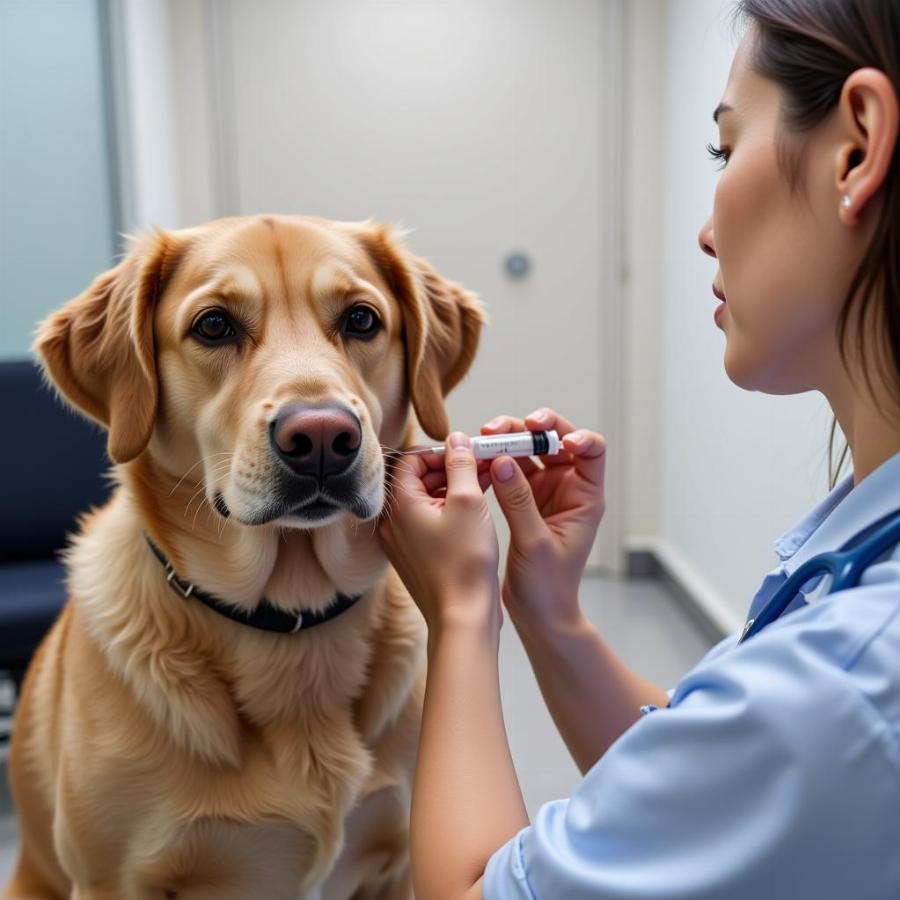Parainfluenza in dogs is a highly contagious respiratory virus that can spread quickly among unvaccinated dogs, especially in kennels, shelters, and dog parks. This comprehensive guide aims to equip dog owners with the knowledge they need to understand, prevent, and manage parainfluenza, ensuring the well-being of their furry companions.
What is Canine Parainfluenza Virus (CPIV)?
Canine parainfluenza virus, often abbreviated as CPIV, is one of the main culprits behind kennel cough, a common respiratory disease in dogs. This virus inflames the upper respiratory tract, specifically the trachea (windpipe) and bronchi (airways leading to the lungs).
Recognizing the Signs: Symptoms of Parainfluenza in Dogs
CPIV typically manifests with mild to moderate symptoms, often mimicking other respiratory infections. Knowing what to look for can help you seek timely veterinary care for your furry friend. Here are the common signs of parainfluenza in dogs:
- Persistent Cough: A harsh, dry, and hacking cough is often the first and most noticeable symptom.
- Runny Nose: Clear to white nasal discharge is common.
- Sneezing: Your dog might sneeze frequently.
- Lethargy: A decrease in energy levels and overall activity is common.
- Loss of Appetite: Your dog may be less interested in food.
- Low-Grade Fever: A slight increase in body temperature may occur.
How Does Parainfluenza Spread?
Canine parainfluenza is highly contagious, spreading through:
- Direct Contact: Close interaction with an infected dog, such as through nose-to-nose contact or sharing toys, can transmit the virus.
- Airborne Transmission: The virus can become airborne through coughing and sneezing, potentially infecting dogs within a certain radius.
- Contaminated Surfaces: CPIV can survive on surfaces like food bowls, water bowls, and kennels for a limited time, posing a risk of infection.
Diagnosis and Treatment of Parainfluenza
If you suspect your dog might have parainfluenza, a visit to the veterinarian is crucial for a proper diagnosis and treatment plan.
Diagnosis: Your veterinarian will perform a physical exam and consider your dog’s medical history. Additionally, they may recommend tests such as:
- Physical examination: Checking for fever, listening to the lungs, and examining the throat.
- Blood tests: To rule out other conditions and assess overall health.
- Nasal or throat swabs: To collect samples for laboratory testing to identify the presence of CPIV.
Treatment: While there’s no specific cure for CPIV, treatment focuses on alleviating symptoms and supporting your dog’s immune system:
- Rest: Adequate rest is crucial for recovery.
- Cough Suppressants: Your veterinarian may prescribe cough suppressants to ease your dog’s coughing.
- Fluids: Encourage your dog to drink plenty of water to stay hydrated.
- Antibiotics: Antibiotics are not effective against viruses; however, they might be prescribed if a secondary bacterial infection is present.
Protecting Your Pup: Prevention Strategies
Prevention is key when it comes to canine parainfluenza. Here’s how you can protect your furry friend:
- Vaccination: Vaccination is the cornerstone of parainfluenza prevention. Discuss the appropriate vaccination schedule for your dog with your veterinarian.
- Hygiene: Maintaining good hygiene practices is essential. Wash your hands thoroughly after handling other dogs and disinfect common areas regularly.
- Limit Exposure: Minimize your dog’s exposure to high-risk environments, such as crowded dog parks, kennels, and shelters, especially during outbreaks.
 Dog Receiving Vaccine
Dog Receiving Vaccine
Living with Parainfluenza: Recovery and Care
Most dogs recover from parainfluenza within one to two weeks with proper care.
Home Care Tips:
- Isolation: Keep your infected dog separated from other dogs to prevent the virus’s spread.
- Comfortable Environment: Provide a quiet, comfortable resting area for your dog.
- Humidifier: Using a humidifier can help soothe irritated airways.
- Nutrition: Offer bland, easily digestible food to entice your dog’s appetite.
Frequently Asked Questions (FAQs)
Can humans get parainfluenza from dogs?
No, canine parainfluenza is species-specific and cannot be transmitted to humans.
How long is a dog with parainfluenza contagious?
Dogs with parainfluenza are typically contagious for one to two weeks, even if they are showing no symptoms.
Is there a vaccine for parainfluenza in dogs?
Yes, vaccination is an effective way to prevent parainfluenza in dogs.
Can my dog get parainfluenza even if they are vaccinated?
While vaccination significantly reduces the risk, it’s still possible for vaccinated dogs to contract a mild form of the virus.
What should I do if I think my dog has parainfluenza?
Contact your veterinarian immediately if you notice any signs of respiratory illness in your dog.
Need More Information?
If you’d like to learn more about caring for your dog’s health or explore other aspects of responsible dog ownership, visit Beaut Dogs at https://beautdogs.com. Our website is a treasure trove of valuable information for dog lovers, offering expert advice on everything from breed-specific care to nutrition and training.
For personalized guidance and support, don’t hesitate to reach out to our team of experts at [email protected]. We’re here to help you navigate the joys and responsibilities of being a dog parent, ensuring your furry friend lives a happy, healthy, and fulfilling life.